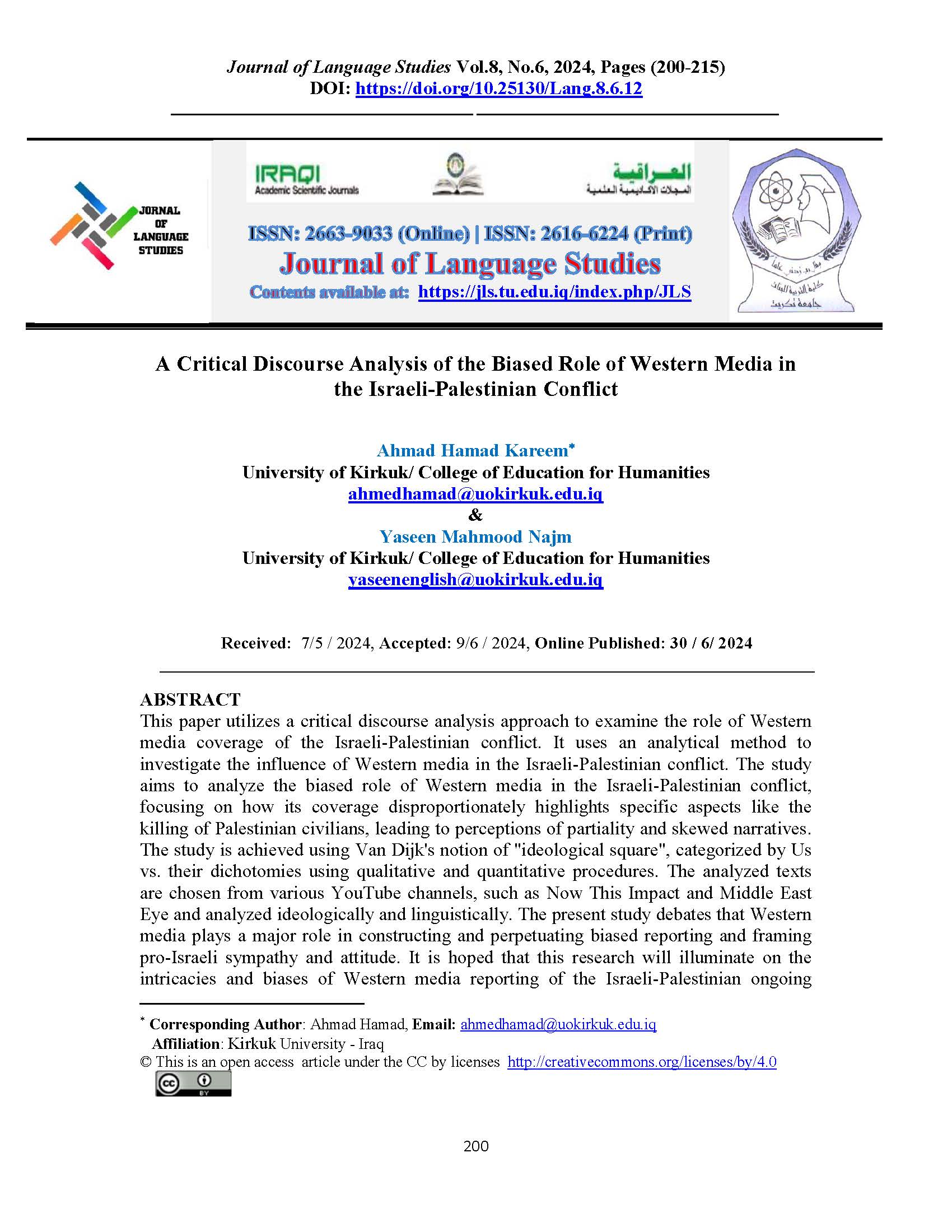A Critical Discourse Analysis of the Biased Role of Western Media in the Israeli-Palestinian Conflict
DOI:
https://doi.org/10.25130/Lang.8.6.12Keywords:
critical discourse analysis, ideology, policy, the israeli-palestinian conflict, and western mediaAbstract
This paper utilizes a critical discourse analysis approach to examine the role of Western media coverage of the Israeli-Palestinian conflict. It uses an analytical method to investigate the influence of Western media in the Israeli-Palestinian conflict. The study aims to analyze the biased role of Western media in the Israeli-Palestinian conflict, focusing on how its coverage disproportionately highlights specific aspects like the killing of Palestinian civilians, leading to perceptions of partiality and skewed narratives. The study is achieved using Van Dijk's notion of "ideological square", categorized by Us vs. their dichotomies using qualitative and quantitative procedures. The analyzed texts are chosen from various YouTube channels, such as Now This Impact and Middle East Eye and analyzed ideologically and linguistically. The present study debates that Western media plays a major role in constructing and perpetuating biased reporting and framing pro-Israeli sympathy and attitude. It is hoped that this research will illuminate on the intricacies and biases of Western media reporting of the Israeli-Palestinian ongoing conflict, with a particular focus on the latest war in Gaza. This research shows that Palestinian representations in Western newspapers are unequivocally negative, often depicting them explicitly or implicitly as combatants, suicide bombers, Islamic militants, and terrorists, underscoring a perceived threat in contrast to Israelis. The findings demonstrate that newspapers shared comparable perspectives on Palestinians and employ nearly identical terminology to characterize them. Also, Western media is biased towards the Israeli side, depicting the Palestinian struggle as aggression while the Israeli attacks as defense and reaction.
References
Adham, R., & Ali, A. (2024). A Critical Pragmatic Study of National Identity Representation in American Political Discourse. Journal of Language Studies, 8(2), 327-348.
Ahmadian, M. (2014). A critical discourse analysis of The Los Angeles Times and Tehran Times on the representation of Iran’s Nuclear Program. Theory and Practice in Language Studies, 4(10).
Alnwairan, M. A., Al Harthy, S. R., Darwish, A. S. & Yacoub, M. A. (2023). To Correct or Not to Correct: The Impact of Written Corrective Feedback on Improving Students' Writing about Literature. World Journal of English Language, 13(7), 336-345.
Axelrod, A. (Ed.). (2001). Encyclopedia of historical treaties and alliances (Vol. 1). Zenda Inc.
Bourdieu, P. (1991). Language and symbolic power. Harvard University Press.
Duncan, J. (1990). The city as text. The politics of Landscape interpretation in the Kan Dyan.
Ellicott, A. (2021). What are the different types of media? Concepts, trends and dimensions. Kanishka Publishers.
Emerson, S. (1992). The Other Fundamentalist. New Republic, June 12, 1995.
Esposito, J. (1992). The Islamic Threat. Oxford University Press.
Fairclough, N. (1993). Discourse and Social Change (Vol. 73). Polity press.
Fairclough, N. (1995). Media Discourse. Edward Arnold.
Fairclough, N. (1995). Critical Discourse Analysis: The Critical Study of Language. Longman.
Finney, N. (2003). The challenge of reporting refugees and asylum seekers. Press wise/ICAR.
Gee, J. P. (2014). An Introduction to Discourse Analysis: Theory and Method (4th ed.). Routledge.
Jassim, A. & Najm,Y. (2023). Unbounded Dependency in English and Arabic: A Lexical- Functional Grammar Approach. Kirkuk University Journal- Humanity Studies, 18(1), 1-20.
Hali, S. M. (2003). Media Imperialism. The Defence Journal. Retrieved from https://www.files.ethz.ch/isn/128264/Report%2020.pdf
Haque, M. (2012). General Concepts of Media. Department of Law, University of Barisal.
Mohammed, M. & Abduljabbar, H. (2024). Exploring the Importance of Contextual Factors in Translating Islamophobia Caricatures. Journal of Language Studies, 8(2), 230-244.
Kant, R. (2012). A study of media for development. In A. Saxena (Ed.), Issues of media content market and technology (pp. 7–13). Kanishka Publishers.
Kumar, N., & Sharmila. (2016). Demonetisation and its impact on Indian economy. International Journal of Humanities, Arts, Medicine and Sciences, 3(10), 23-26.
Lee, D. D. (1954). Symbols and Values: An Initial Study. Conference on Science, Philosophy, and Religion in Their Relation to the Democratic Way of Life, Inc.
Moeller, S. D. (1999). Compassion fatigue: How the media sell disease, famine, war and death. Psychology Press.
Mousa, I. (2000). The making of the media in the West. In L. A. Gher & H. Y. Amin (Eds.), Civic discourse and digital age communication in the Middle East.
Najim, Y. (2012). A Syntactic Study of the Overlap between Substitution and Reference. Kirkuk University Journal- Humanity Studies, 7(4), 1-33.
Nwankwo, C. (2011). The role of the media in promoting human rights: An analysis of the BBC documentary, chocolate: The bitter truth. School of Global Studies, Tromso, Norway: University of Gothenburg.
Rajan, M. (2011). Media in modern India. Deep and Deep publications.
Roe, E. (1994). Narrative Policy Analysis: Theory and Practice. Duke University Press.
Singh, N. (2017). Role and impact of media on society: A sociological approach with respect to demonetisation. IMPACT: International Journal of Research in Humanities, Arts and Literature (IMPACT: IJRHAL), 5(10), 127-136.
Schiffrin, D., Tannen, D., & Hamilton, H. E. (Eds.). (2001). The Handbook of Discourse Analysis. Blackwell Publishing.
Van Dijk, T. A. (1998). Discourse analysis as ideology analysis. Language and Peace, 10, 47-142.
van Dijk, T. A. (2008). Discourse and Power. Palgrave Macmillan.
Viser, M. (2012). Attempted objectivity: An analysis of the New York Times and ha' aretz and their portrayals of the Palestinian-Israeli conflict. Harvard International Journal of Press Politics.
Wodak, R., & Meyer, M. (2011). Critical discourse studies: A sociocognitive approach. In R. Wodak & M. Meyer (Eds.), Methods of critical discourse analysis (2nd ed., pp. 62-86). Sage.
Zetter, R. (2007). More labels, fewer refugees: Remaking the refugee label in an era of globalization. Journal of refugee studies, 20(2).

